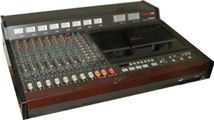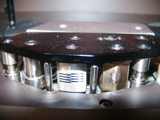DIY: The Mighty Tascam 388
 The first recording band I was in made albums on an all-in-one portable studio with eight tracks of audio on 1/4-inch, analog tape. Having cut my teeth until then on various four-track cassette decks, I found this reel-to-reel, hard-wired hulk with close-to-pro EQ and signal routing to be something like a miracle. Next to other home-recording setups, it was powerful and elegant and seemingly capable of whatever we imagined. It was called the Tascam 388 Studio 8.
The first recording band I was in made albums on an all-in-one portable studio with eight tracks of audio on 1/4-inch, analog tape. Having cut my teeth until then on various four-track cassette decks, I found this reel-to-reel, hard-wired hulk with close-to-pro EQ and signal routing to be something like a miracle. Next to other home-recording setups, it was powerful and elegant and seemingly capable of whatever we imagined. It was called the Tascam 388 Studio 8.
I bought my 388 with a timely loan (begging is underrated) from Mom and Dad in 1987. Around that time, the only other 388 I knew of belonged to singer-songwriter Kowtow Popof. We both loved the comprehensive design, the simplicity, the sound quality. Most everybody else was using old 1/2-inch reel-to-reels and converted live mixers, and considered the 388 a sort of gimmicky aberration. Others were still making do with their four-tracks (“I just need to make demos, man”), and considered the 388 prohibitively expensive.
 But the 388 was an exceptional machine, at that price ($3,000) or a higher one.
But the 388 was an exceptional machine, at that price ($3,000) or a higher one.
Like all well-designed tools — think of Apple products today — the 388 was intuitive, easy to use, and more capable than the amateur piloting it. In an era when the term “patch bay” sowed nausea in the guts of recordists, the 388 was the first decent-sounding, mass-market machine to eliminate the brambles of external routing between recorder and mixer.
Years later I learned that singer-songwriter Alice Despard had also been using a 388 during that period. East River Pipe had used a 388 to create Shining Hours in a Can and other seminal albums in his Queens apartment. The Black Keys had made their early records on a 388. I began to realize that this versatile, all-in-one multitrack had been operating in the lairs of half the obscure songwriters of the late ’80s and early ’90s. Recently, when I ran into J. Scott Watson, formerly of The Intentions, he mentioned, out of the blue, that he had owned and used a Tascam 388.
Eventually we all moved on to ADATs and hard disks and the greater magic of digital audio workstations. The 388s, many of which by then needed new tape heads, fell to the purists on eBay.
I realize now that the Tascam 388 was emblematic of the burgeoning DIY aesthetic, that it symbolized for some singer-songwriters a proud self-sufficiency. We hated ponying up for commercial studio time. And we thought, before the advent of the independent studio, that there might be a better way.
Turned out there was.

I think I remember when you bought this. You found a great price somewhere and brought it to the attention of the local “We’ll beat any price” guys who implored you to “please don’t tell anybody” about the good price. It’s also possible that you used this device as the very first and very last producer of the Singing Big Guys. Yes, this purchase was historic in the annals of rock and roll history.
Damn, you’re right… but Wurlitzer and LaSalle were gouging. Had to give ’em a comeuppance. I believe we tracked the SBG session on the 388’s precursor, the vaunted Tascam 246 (maybe the greatest cassette ministudio of all time).
Although of an different vintage, I had a similar experience with the Roland VS-880. Two friends of mine at the time were making their albums (BE – Thistupidream & Jump Rope Girls – Eight Track Demos) on this portable little unit, which encouraged me to buy one. Without that, ‘texas’ would not have come to be.
Yeah, I remember drooling over the VS-880 when it came out. It played to my Portastudio sympathies… but it was digital! One of those “brave new world” pieces of gear…
I still use it for instances where I don’t wanna drag my whole ProTools rig. And sometimes I use it as an outboard effects unit, since it’s got some tricks that I haven’t found replicated elsewhere.
Ain’t it the way. Wish I still had my old “Effectron” rack unit, which had flange and chorus sounds now lost to history…
I occasionally pull out my old cheapo foot pedals for effects on recordings that aren’t in the standard packages. My Jon Brion aspirations need only more time for garage sale shopping…
Yes, I still have a TASCAM port-a-studio in my basement…the little 4-track cassette model.
I recorded a lot on that console in walk-in closets in my group houses and an apartment.. You could really experiment and be totally free because there was no one listening except the clothes hangers. I remember being hunched over for hours over that fantastic little machine. It was intuitive. It was beautiful in form and function. It opened me up to the vast world of recording production. It helped me realize what a plastic and sculptural medium my music could become on tape. Yes, I had already recorded in 8 and 16 track recording studios on reel-to-reel with full outboard effects and an engineer, but this was hands-on, homemade stuff. In 1988, Hyaa! recorded an EP worth of material on a 388 with Rob Gillette at the helm. We only recently got to hear those tracks, 20 years later. They sound great! Since MP3s are so compressed, the 1/4 inch reel narrow headroom is not noticeable. My husband, Stuart Chandler, also recorded a masterpiece of an album in the late 80’s on the cassette version…his was a similar Yamaha unit, I think. Both decks lie side-by-side in a closet. We will never part with them. They are old friends.
Wow, is the Hyaa! EP going to see the light of day? Hope so!
I really don’t know…All I have are the crummy MP3 versions.
Damn — ya beat me to it.
I don’t feel that I unduly romanticize my 388 — it earned all of the love that I continue to direct its way. You could close your eyes and still mix an entire record, even knowing that you had external sends and returns pumping away. You could defeat the noise-reduction on a single track so that you could print a time-code onto that track — which I did, over and over. Proving only that I was bereft o’ programming skills, and should never have even tried.
But who needed programming and time code? You could grab five drum mics in, “pre-mix” and print on two tracks for a stereo drum mix, lay down a bass and an electric guitar, and
holy shit, four tracks remain!
Without any reduction mixes (the dreaded bouncing down)!
On 1/4″ tape — no cassette involved!
Or keep kick and snare on separate tracks, record live, and still have room. Without ever grabbing a patch cable.
Just looking at the photos above makes me weak in the knees.
Of course, an adult love affair wouldn’t be possible without acknowledging the imperfections of the object of my affections. Alice is right — an mp3 masks the one problem that the 388 had — headroom. Well, headroom, and upper-frequency recording. And buss faders. And. . . Amongst our weaponry are such. . . .
But let me tell you, the 388’s ass *did* look great in that dress!
As I told you, mister D., I had the heads re-lapped in1998, and it rendered all of my prior recordings unlistenable. But I still have mine, and still use it.
That 388 makes Logic and Pro Tools seem
so cold. I love the young things, of course, but I’ll never forget “The One.”
So true about the headroom — and that skinny li’l 1/4-inch reel could never quite capture all the bass. But as a lab for the aspiring Mad Scientist, peerless!
a lab for the aspiring Mad Scientist”
Truer words was never spoke
I wish I’d spent a little more time experimenting, and a little less time trying to recreate what I was hearing come out of professional [but home] studios like Hit and Run and Inner Ear.
I drove out to my storage space and had a moment’s reverie looking at her. And glancing at my Ampex boxes of 7 1/2-inch tapes, waiting to be unearthed. Then I snapped awake, knowing I don’t have enough room for the gear I’m using now, and knowing that once I re-lapped the heads, I had forever ruined the machine.
Waaaaaah
Consider getting your old Ampex tracks dumped (from some other, unrelapped heads) to 24-bit WAVs. I did it after parting with my 388, and it helped douse my sorrows. Now I can remix old songs from the 388 while I’m supposed to be cutting the grass or making a living or anything like that. Great therapy!
Where does one get 388 tapes transferred to 24-bit WAVs? I’m assuming it is very expensive, but would be worth it if i can’t find a “new” 388 with good (w-heads not relapped) so i can remix all my old stuff on DAW. thanks for any help you can give.
Hi,
I was just reading your post and was curious about the “relapping of the heads on the 388 and that it rendered all of your old recording useless”! Why is that?! I was thinking about getting mine relapped but after reading your post, I am more than a little concerned, because I have loads of old tapes that I want to remix. Any info would be much appreciated.
what Scott said!
Hi, I own a tascam 388 studio 8. How does it compare to ProTools whenever recording an acoustic instrument such as a guitar or piano? I haven’t yet recorded anything on it and I was just curious on how it stands against current recording software.
Late to the game but this was a cool write up on the 388. It still obviously has a huge cult following and rightly so. I’ll listen to a record just because it was recorded on old gear.
I did this one using 2 mics and a 388.
http://www.thecrookedsaws.bandcamp.com
I recorded an album on my Tascam 388. What I do is record guitars, organs, piano, vocals and drums on eight tracks then transfer them to Sonar where I record bass, backing vocals and whatever else I think the song needs. You can hear some samples here: https://soundcloud.com/the-autumn-stone
What years were the 388 manufactured? I bought a Tascam Porta 1 in 1985. Cost like $600, which was a lot back then! Quality was Ok but not as good as 388 of course.
JUST SCORED!!! Brand new Tascam 388 in a hard travel case, amazing enough…Hasn’t been touched in 20 years, needs new capstan belt, but other than that barely any dust in the thing…i opened it up its a work of art, its really beautiful on the inside…This machine was built 2 years after I was born, a time when Gear and music alike were crafted with precision and care by master craftsmen, instead of fast/food FM culture that I see more today…
Recorded two albums on a 388 in the mid-eighties. Unmatched simplicity and versatility. Normally we’d do six tracks, mixdown to the other two, then add another six. Now that we’re digital I do so miss those buttons and sliders!
Had my 388 stored away for 20+ years! Replaced the belt. Very easy repair. Plan to record drums & bass w/it; then dump into Logic. Can’t believe these still have a great following. Thought mine was history; no output from headphone jacks! No worries. The stereo/monitor outs work fine so I patched in a mini Roland VM-3100 digital mixer w/ great fx & a headphone jack. Possibilities now are endless; the 388 sits next to my drum kit so I can easily mix the sound. Looking forward to recording acoustic & electric guitars too. Think this might give my songwriting a jolt of inspiration too. Viva King Melody!
I love this slice into such a critical moment for creative development just before the dam broke and everything went upside down. What a great piece of gear the 388 was/is!
I still own and use the Mighty 388.
Though I mostly work in ProTools or Adobe Audition, I do still pull out the 388 when I’m looking for that analog tape hiss type of sound.